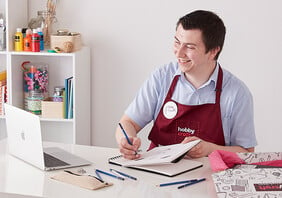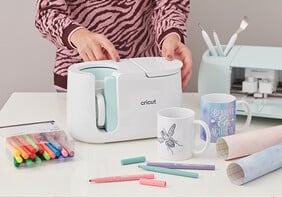How to Print with Recycled Plastic
Combine traditional block printing with plastics that would normally be single-use and you have a new craft tool! The fun of using found plastics is that no two prints will look the same!
Less wasteful, time consuming and water-heavy than other printing methods, it's an environmentally friendly, sustainable and unique way to make custom artworks. With the right materials, you could print onto and customise paper, fabric, glass, card, acrylic, metal, wood and many more surfaces for lots of different craft projects.
Project and instructions by Rachel Elinor Toye
You will need
How to make
You will also need:
* Scrap plastic packaging that would normally be single use, recycled or thrown away.
* Water and dish soap to clean materials – save water by filling a bucket or bowl instead of running the tap often.
* Spoon (to scoop printing medium cleanly).
Time to scavenge for interesting bits of plastic! Have a rummage in your recycling bin or keep an eye out for pieces before you think about throwing them away.
The best pieces for print making will have different ridges, patterns, and textures.
Tip: Make sure the plastic is clean before starting to print with it, use a bit of soap and water to remove any dirt or grease.

Using a pair of scissors, carefully cut the plastic down to a suitable size that works with your paper (be careful, the edges can be sharp)!
It can be smaller and repeated across your page into a pattern, or one larger statement piece.
Tip: Leave a lip on one side of your plastic that can be sued as a handle when printing with it, this will make lifting and placing the piece much easier.

Choose your colours of acrylic paint and squeeze a small amount onto the printing tray, add the same amount of printing medium and mix together until one harmonious colour and texture has been achieved.
The printing medium slows the drying time of the paint, and allows the paint mixture to be an even texture when using the roller.

Dip the roller into the ink and roll across the printing tray using firm pressure in multiple directions until an even coating of colour is achieved on the rubber part of roller.
If you have an extra printing tray you can use it to roll off excess ink from the roller as you try to get a smooth coverage of colour, or as somewhere to keep your plastic pieces to avoid messy surfaces.

Coat one side of your chosen piece of plastic in the ink by rollering back and forth across the surface until fully covered. You could also dip the plastic directly into the ink.
Experiment and test these methods as each will apply the ink differently and change the effect once printed.

Place the inked side of the plastic onto the paper and press down ensuring contact is made across the entire piece.
How firmly you press will provide different results. More pressure means a denser, solid colour and a lighter pressure gives different textures and patterns in the ink.
Use a clean roller to roll across the back for a smoother and more predictable print.

Carefully lift the plastic off the paper by grabbing the 'handle' or the corner of the plastic.
You might have to steady or peel the paper away too; this helps release the suction from the ink.
Try not to touch the wet piece of plastic on the paper as you remove it - if you do, just print over it!
Place the plastic piece to one side ready to recoat.

Repeat steps four, five, six and seven until your paper is full.
This could be in a regimented repeat pattern like stripes, bricks or mirrored.
You could also cover the page in a more abstract and irregular fashion, layering different colours or mixing and matching stamping with different pieces of plastic.
You can wash and re-use your different plastic stamp over and over – the combinations are endless!










